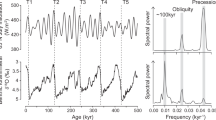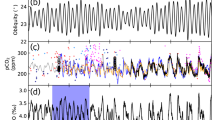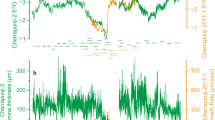Abstract
Many palaeoclimate records from the North Atlantic region show a pattern of rapid climate oscillations, the so-called Dansgaard–Oeschger events, with a quasi-periodicity of ∼1,470 years for the late glacial period1,2,3,4,5,6. Various hypotheses have been suggested to explain these rapid temperature shifts, including internal oscillations in the climate system and external forcing, possibly from the Sun7. But whereas pronounced solar cycles of ∼87 and ∼210 years are well known8,9,10,11,12, a ∼1,470-year solar cycle has not been detected8. Here we show that an intermediate-complexity climate model with glacial climate conditions simulates rapid climate shifts similar to the Dansgaard–Oeschger events with a spacing of 1,470 years when forced by periodic freshwater input into the North Atlantic Ocean in cycles of ∼87 and ∼210 years. We attribute the robust 1,470-year response time to the superposition of the two shorter cycles, together with strongly nonlinear dynamics and the long characteristic timescale of the thermohaline circulation. For Holocene conditions, similar events do not occur. We conclude that the glacial 1,470-year climate cycles could have been triggered by solar forcing despite the absence of a 1,470-year solar cycle.
This is a preview of subscription content, access via your institution
Access options
Subscribe to this journal
Receive 51 print issues and online access
$199.00 per year
only $3.90 per issue
Buy this article
- Purchase on Springer Link
- Instant access to full article PDF
Prices may be subject to local taxes which are calculated during checkout




Similar content being viewed by others
References
Bond, G. et al. Correlations between climate records from North Atlantic sediments and Greenland ice. Nature 365, 143–147 (1993)
Grootes, P. M., Stuiver, M., White, J. W. C., Johnson, S. & Jouzel, J. Comparison of the oxygen isotope records from the GISP2 and GRIP Greenland ice cores. Nature 366, 552–554 (1993)
Sachs, J. P. & Lehman, S. J. Subtropical North Atlantic temperatures 60,000 to 30,000 years ago. Science 286, 756–759 (1999)
Spötl, C. & Mangini, A. Stalagmite from the Austrian Alps reveals Dansgaard–Oeschger events during isotope stage 3: Implications for the absolute chronology of Greenland ice cores. Earth Planet. Sci. Lett. 203, 507–518 (2002)
Voelker, A. H. L. et al. Global distribution of centennial-scale records for marine isotope stage (MIS) 3: a database. Quat. Sci. Rev. 21, 1185–1212 (2002)
Schulz, M. On the 1470-year pacing of Dansgaard–Oeschger warm events. Paleoceanography 17, doi:10.1029/2000PA000571 (2002)
van Geel, B. et al. The role of solar forcing upon climate change. Quat. Sci. Rev. 18, 331–338 (1999)
Stuiver, M. & Braziunas, T. F. Sun, ocean, climate and atmospheric 14CO2: an evaluation of causal and spectral relationships. Holocene 3, 289–305 (1993)
Beer, J. et al. in The Sun as a Variable Star: Solar and Stellar Irradiance Variations (eds Pap, J. M., Fröhlich, H., Hudson, S. & Solanki, S. K.) 291–300 (Cambridge Univ. Press, Cambridge, 1994)
Peristykh, A. N. & Damon, P. E. Persistence of the Gleissberg 88-year solar cycle over the last ∼12,000 years: Evidence from cosmogenic isotopes. J. Geophys. Res. 108, 1003, doi:10.1029/2002JA009390 (2003)
Wagner, G. et al. Presence of the solar de Vries cycle (∼205 years) during the last ice-age. Geophys. Res. Lett. 28, 303–306 (2001)
Lean, J. & Rind, D. Climate forcing by changing solar radiation. J. Clim. 11, 3069–3094 (1998)
Alley, R. B., Anandakrishnan, S. & Jung, P. Stochastic resonance in the North Atlantic. Paleoceanography 16, 190–198 (2001)
Alley, R. B., Anandakrishnan, S., Jung, P. & Clough, A. in The Oceans and Rapid Climate Change: Past, Present and Future (eds Seidov, D., Maslin, M. & Haupt, B. J.) 57–68 (AGU Geophys. Monogr. 126, Washington, D.C., 2001)
Rahmstorf, S. Timing of abrupt climate change: A precise clock. Geophys. Res. Lett. 30, 1510, doi:10.1029/2003GL017115 (2003)
Keeling, C. D. & Whorf, T. P. The 1,800-year oceanic tidal cycle: A possible cause of rapid climate change. Proc. Natl Acad. Sci. USA 97, 3814–3819 (2000)
Bond, G. et al. Persistent solar influence on North Atlantic climate during the Holocene. Science 294, 2130–2136 (2001)
Ganopolski, A. & Rahmstorf, S. Rapid changes of glacial climate simulated in a coupled climate model. Nature 409, 153–158 (2001)
Ganopolski, A. & Rahmstorf, S. in The Oceans and Rapid Climate Change: Past, Present and Future (eds Seidov, D., Maslin, M. & Haupt, B. J.) 261–275 (AGU Geophys. Monogr. 126, Washington, D.C., 2001)
Ganopolski, A. & Rahmstorf, S. Abrupt glacial climate changes due to stochastic resonance. Phys. Rev. Lett. 88, 038501 (2002)
Weber, S. L., Crowley, T. J. & van der Schrier, G. Solar irradiance forcing of centennial climate variability during the Holocene. Clim. Dyn. 22, 539–553 (2004)
Neff, U. et al. Strong coherence between solar variability and the monsoon in Oman between 9 and 6 kyr ago. Nature 411, 290–293 (2001)
Hodell, D. A., Brenner, M., Curtis, J. H. & Guilderson, T. Solar forcing of drought frequency in the Maya lowlands. Science 292, 1367–1370 (2001)
Haigh, J. D. The role of stratospheric ozone in modulating the solar radiative forcing of climate. Nature 370, 544–546 (1994)
Shindell, D., Rind, D., Balachandran, N., Lean, J. & Lonergan, P. Solar cycle variability, ozone, and climate. Science 284, 305–308 (1999)
Carslaw, K. S., Harrison, R. G. & Kirkby, J. Cosmic rays, clouds and climate. Science 298, 1732–1737 (2002)
Schmittner, A., Yoshimori, M. & Weaver, A. J. Instability of glacial climate in a model of the ocean–atmosphere–cryosphere system. Science 295, 1489–1493 (2002)
Lohmann, G. & Gerdes, R. Sea ice effects on the sensitivity of the thermohaline circulation in simplified atmosphere–ocean–sea ice models. J. Clim. 11, 2789–2803 (1998)
Ogurtsov, M. G., Nagovitsyn, Y. A., Kocharov, G. E. & Jungner, H. Long-period cycles of the Sun's activity recorded in direct solar data and proxies. Solar Phys. 211, 371–394 (2002)
Ram, M. & Stolz, M. Possible solar influences on the dust profile of the GISP2 ice core from Central Greenland. Geophys. Res. Lett. 26, 1043–1046 (1999)
Acknowledgements
We thank N. Latuske for insight into spectral analysis; M. Claussen, R. Calov and E. Bauer for support and helpful comments; and the late G. Bond for his support and for many discussions that helped to improve the quality of this study. C.K. was funded by a subcontract to a project of the Bundesministerium für Bildung und Forschung (BMBF).
Author information
Authors and Affiliations
Corresponding author
Ethics declarations
Competing interests
Reprints and permissions information is available at npg.nature.com/reprintsandpermissions. The authors declare no competing financial interests.
Supplementary information
Supplementary Discussion 1
This discusses the stability of the simulated 1,470-year climate cycle. We consider changes in the forcing parameters, we incorporate noise in the freshwater forcing, and we discuss the robustness of the model response when a more realistic forcing is used with spectral properties close to that observed in solar proxies. (PDF 94 kb)
Supplementary Discussion 2
In this section, we illustrate the dynamics of the simulated DO events. This is done by comparing the response of the climate system model CLIMBER-2 with that of a very simple conceptual model which only accounts for two features of the THC, the large characteristic timescale and the high degree of non-linearity (PDF 113 kb)
Supplementary Figure 1
This figure shows the stability of the simulated 1,470-year climate cycle with respect to changes of the forcing frequencies of the two sinusoidal freshwater components. Each of the two forcing periods is varied over decades while the second cycle is at a fixed period. (PDF 98 kb)
Supplementary Figure 2
This figure shows the stability of the simulated 1,470-year climate cycle with respect to changes of the forcing frequencies of the two sinusoidal freshwater components. Both forcing periods are varied simultaneously such that the ratio of the two forcing frequencies is nearly fixed. (PDF 80 kb)
Supplementary Figure 3
This figure shows the stability of the simulated 1,470-year climate cycle with respect to variations of the forcing amplitudes of the two sinusoidal freshwater components. Both forcing amplitudes are varied simultaneously while their sum is fixed. (PDF 93 kb)
Supplementary Figure 4
This figure shows the stability of the simulated 1,470-year climate cycle with respect to additional noise in the freshwater fluxes. By varying the noise level and the forcing amplitudes, three different values are prescribed for the signal-to-noise ratio. (PDF 236 kb)
Supplementary Figure 5
additional noise in the freshwater fluxes. For a fixed noise level, the amplitude of each single forcing cycle is varied while the amplitude of the second cycle is fixed. (PDF 395 kb)
Supplementary Figure 6
This figure illustrates the basic idea of the simple conceptual model that we apply to clarify the dynamics of the DO events simulated by the climate system model CLIMBER-2. (PDF 134 kb)
Supplementary Figure 7
This figure shows the response of the conceptual model to the applied forcing for different amplitudes of the two sinusoidal freshwater cycles. (PDF 300 kb)
Supplementary Figure 8
This figure shows the stability of the simulated 1,470-year climate cycle with respect to changes of the forcing frequencies of the two sinusoidal freshwater components. In both the conceptual model and the climate system model CLIMBER-2, the two forcing periods are varied simultaneously such that the ratio of the two forcing frequencies is nearly fixed. (PDF 86 kb)
Rights and permissions
About this article
Cite this article
Braun, H., Christl, M., Rahmstorf, S. et al. Possible solar origin of the 1,470-year glacial climate cycle demonstrated in a coupled model. Nature 438, 208–211 (2005). https://doi.org/10.1038/nature04121
Received:
Accepted:
Issue Date:
DOI: https://doi.org/10.1038/nature04121
This article is cited by
-
Unleashing the power of the Sun: the increasing impact of the solar cycle on off-season super typhoons since the 1990s
npj Climate and Atmospheric Science (2023)
-
Correlation analysis between the occurrence of epidemic in ancient China and solar activity
Science China Earth Sciences (2023)
-
Decadal–centennial-scale solar-linked climate variations and millennial-scale internal oscillations during the Early Cretaceous
Scientific Reports (2022)
-
Asian monsoon intensity coupled to Antarctic climate during Dansgaard–Oeschger 8 and Heinrich 4 glacial intervals
Communications Earth & Environment (2022)
-
A Jurassic record encodes an analogous Dansgaard–Oeschger climate periodicity
Scientific Reports (2022)
Comments
By submitting a comment you agree to abide by our Terms and Community Guidelines. If you find something abusive or that does not comply with our terms or guidelines please flag it as inappropriate.



